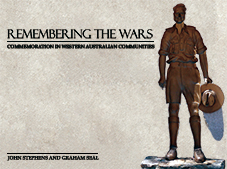‘Review note: Stephens and Seal’s Remembering the Wars: Commemoration in Western Australian Communities‘, Honest History, 6 February 2016
Anyone who’s spent time in country Australia will have noticed the centrality of a war memorial to nearly every community. Recently, memorials have also been recognised as a rich source for historians studying how communities dealt with conflict and its aftermath. A new addition to this literature is Remembering the Wars: Commemoration in Western Australian Communities by John Stephens and Graham Seal.
 Stephens and Seal write engagingly about some 70 of the 900 war memorials across Western Australia. Their sample spans the earliest memorials (circa 1916) to some of the most recent (2014). Importantly, Stephens and Seal not only describe the memorials as physical objects but use them as artefacts to narrate the remembrance of the communities that established and use them. For example, the communal construction of two memorials, 90 years apart – Anzac Cottage in 1916 and the Wheatbelt Vietnam Veterans’ Memorial in 2006 – suggests the value of building processes themselves, to both citizens and veterans.
Stephens and Seal write engagingly about some 70 of the 900 war memorials across Western Australia. Their sample spans the earliest memorials (circa 1916) to some of the most recent (2014). Importantly, Stephens and Seal not only describe the memorials as physical objects but use them as artefacts to narrate the remembrance of the communities that established and use them. For example, the communal construction of two memorials, 90 years apart – Anzac Cottage in 1916 and the Wheatbelt Vietnam Veterans’ Memorial in 2006 – suggests the value of building processes themselves, to both citizens and veterans.
More than a hundred colour images and a number of personal stories further enliven the book, although some anecdotes (such as ‘a flock of seagulls’ in Geraldton in 2008 ‘[flying] over the Australian flag and [heading] out to sea “in formation” as a portent of the approval of the missing [HMAS] Sydney sailors’, p. 149) beg further interrogation. The book is especially strong on more unconventional memorials, including those that provided early recognition of Indigenous Australians, women and prisoners of war, and forms such as churches, torpedoes and statues of former enemies.
Aside from being immensely interesting in their own right, these unconventional war memorials are a useful corrective to a view of Australian memorials that mostly relies on east coast examples. Stephens and Seal show how Western Australia has attempted to construct a special relationship to the Anzac legend through its memorials, especially as the departure point of the first ‘Anzac’ convoy in 1914. They also show how some forms of memorials that are familiar from other states, including post-World War I soldier statues, arches and broken pillars, are rare in Western Australia. Unfortunately, the value of this aspect of the book is diminished by inadequate cross-referencing. For example, the promise of an explanation of the rarity of the soldier statue type made on page 30 is fulfilled on page 106, but casual readers would benefit from more specific direction to the material. A map showing the ten geographic regions that provide the structure of the book would also have been welcome.
Overall, Remembering the Wars is a welcome addition to the literature about war memorials and will be of interest to historians (including family and local historians), educators, and historically-minded travellers.
Ashleigh Gilbertson
Ashleigh Gilbertson teaches high school in rural Victoria and is a doctoral candidate at the University of Adelaide, where her thesis is a military and cultural history of Australians and the Battle of Passchendaele (Third Ypres) during and after World War I. She blogs at Milstorical.

